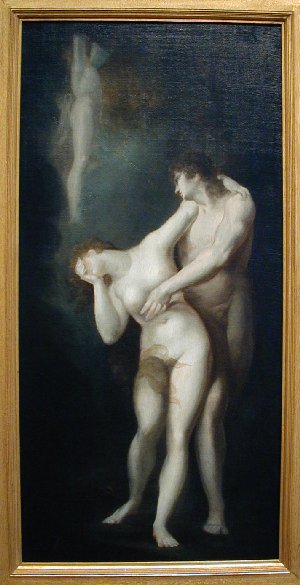Fuseli's Nightmare
Today, a prophetic nightmare disturbs our sleep. The University of Houston's College of Engineering presents this series about the machines that make our civilization run, and the people whose ingenuity created them.
The Nightmare is a painting you've surely seen. It's not easy to forget. A woman in white lies on a divan in front of dark red drapes. Her head and arms are thrown back in tormented sleep. A ghastly demon sits on her chest leering at the viewer.
You saw the picture in ads for an offbeat, surrealistic movie called Gothic. It was about Shelley and Lord Byron in Switzerland. The movie imagined how Mary Shelley might have written the book Frankenstein. I liked the poster far more than I liked the movie. I wonder if the advertising people knew the strange ways that painting touched Mary Shelley's life.
The artist was Henry Fuseli, a Swiss who moved to London in 1779. His last Swiss painting showed soldiers swearing an oath on their swords -- typical 18th-century art about revolution. It was workmanlike stuff, but Fuseli's mind was elsewhere. He wanted his paintings to be revolution, not just to glorify it.
England gave him the elbow room Switzerland had denied him. He painted The Nightmare soon after he got there. He was among the first who took up such themes of Gothic intensity in art and literature. He began changing revolution by the sword into a revolution of the human psyche. He anticipated Shelley and Byron.
Fuseli was soon part of a group of London intellectuals. At the center of the group was Mary Wollstonecraft, the author of modern feminism. She too walked the late-18th-century road away from political change to a revolution of creative consciousness.
In 1792 Henry Fuseli and Mary Wollstonecraft tangled in a very strange affair. She turned the white heat of her platonic love on him. Fuseli was drawn in for a time. Then Mary went to his wife with a bizarre proposition. Since her love was innocent, shouldn't the three of them live together? With that, Fuseli had to end their odd unconsummated affair.
Mary Wollstonecraft went on to marry someone else. Then she died giving birth to the girl who would become Mary Shelley. Nineteen years later, back in Fuseli's Switzerland, Mary Shelley wrote Frankenstein as an exercise in Gothic style. The day of Gothic novels was past by then, but Frankenstein became the most famous Gothic novel of them all.
So that odd movie poster summons up the people who set a new agenda for inventive minds, 200 years ago. Fuseli told us we must find our revolution in the Gothic inner reaches of our minds. And Mary Shelley called up the Gothic nightmare one last time with her man-made nightmare -- with the monster that's given us all bad dreams ever since.
I'm John Lienhard, at the University of Houston, where we're interested in the way inventive minds work.
(Theme music)
Le Bris, M., Romantics and Romanticism. New York: Rizzoli International Publications, Inc., 1981.
Wardle, R.M., Mary Wollstonecraft. Lawrence, KA: University of Kansas Press, 1951.
Bindman, D., Blake as an Artist. New York: E.P. Dutton, 1977.

The Dismission of Adam and Eve from Paradise, Henry Fuseli, 1796-99